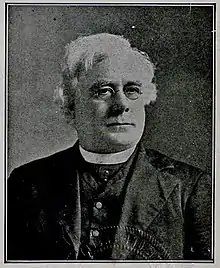Andrew Arnold Lambing
Monsignor Andrew Arnold Lambing or Rev. A. A. Lambing (1842–1918) was an American Roman Catholic priest and historian. He was one of the nation's foremost priest-historians, having founded the first Catholic historical society in the United States (The Ohio Valley Catholic Historical Society, in February 1884) as well as the first Catholic historical quarterly.

Born in a hamlet that became Manorville, Armstrong County, Pennsylvania, adjacent to Ford City, he worked as a boy on his family's farm. As an adolescent he labored in a brick yard and in the pioneering oil business of Samuel Kier on the Allegheny River. At age 21 Lambing entered St. Michael's Preparatory and Theological Seminary in Pittsburgh, was ordained in 1869 by Bishop Michael Domenec, and was briefly assigned to teach history at St. Francis College, Loretto. Thereafter, during forty years of Pittsburgh's post-Civil War, industrial and population boom, he ministered to thousands of the city's Catholic immigrants from Europe. During the Great Railroad Strike of 1877, he was credited with calming some strikers intent on destroying a freight depot of the Pennsylvania Railroad in the city's rail yards.
Lambing was among the first academically-trained historians of Western Pennsylvania and the first to document the beginnings of the Catholic Church there. Two of his most important contributions were the first English translation, from the French, of the 1749 journal of Pierre Joseph Céloron de Blainville and the publication of the register of baptisms at Fort Duquesne. He wrote numerous articles for newspapers and magazines on historical and religious subjects, including a majority of two early and significant regional histories: History of Allegheny County and the Standard History of Pittsburgh. He served as president of the Historical Society of Western Pennsylvania. Andrew Carnegie appointed Lambing a trustee of both the Carnegie Institute of Pittsburgh and the Carnegie School of Technology. In 1883 the University of Notre Dame conferred on him the honorary degree of Master of Arts and in 1886 the Doctor of Laws. He died Christmas Eve, 1918, and is buried in the priest’s section at St. Mary Cemetery in the city's Lawrenceville neighborhood. His headstone is in the shape of a large open book.
Books
- The Orphan’s Friend: A Series of Plain Instructions for the Use of Orphans after Leaving the Asylum, and for Persons of the Same Class Living in the World, nonfiction (New York: D. & J. Sadlier & Company, 1875)
- The Sunday School Teacher’s Manual, or, the Art of Teaching Catechism..., nonfiction (New York, Cincinnati [etc.]: Benziger Brothers, 1877.)
- A History of the Catholic Church in the Dioceses of Pittsburgh and Allegheny from Its Establishment to the Present Time, nonfiction (New York, Cincinnati [etc.]: Benziger Brothers, 1880.)
- Masses for the Dead, and the Motive for Having Them Celebrated, nonfiction (Notre Dame, IN: Ave Maria Press, 1881.)
- The Baptismal Register of Fort Duquesne, from June, 1754, to Dec. 1756, Translated from the French, with an Introductory Essay and Notes, by Rev. A. A. Lambing, nonfiction (Pittsburgh: Myers, Shinkle & Co., 1885.)
- The Sacramentals of the Holy Catholic Church, nonfiction (New York, Cincinnati [etc.]: Benziger Brothers, 1892.)
- Come, Holy Ghost, or, Edifying and Instructive Selections from Many Writers on Devotion to the Third Person of the Adorable Trinity, nonfiction (St. Louis: B. Herder, 1901.)
- Brief Biographical Sketches of the Deceased Bishops and Priests Who Labored in the Diocese of Pittsburgh: From the Earliest Times to the Present, with an Historical Introduction, nonfiction (Pittsburgh: Republic Bank Note Co., 1914.)
- Expedition of Celoron to the Ohio Country in 1749, nonfiction (Columbus, OH: The F.J. Heer Printing Co., 1921.)
Sources
- Armstrong County, Pa.: Her People, Past and Present. Pages 413-414, J. H. Beers & Co., 1914.
- The Catholic Historical Review. Pages 435-437, Catholic University Press of America, Vol. 1, No. 4, January 1916.
- The Historiography of the American Catholic Church, 1785-1943. Pages 37–39, Ayer Publishing, 1978.
- The Progressive Men of the Commonwealth of Pennsylvania. Pages 70–71, A. W. Bown & Co., 1900.